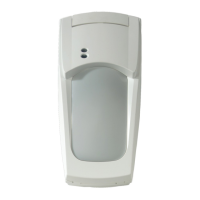8 / 64 P/N 145797999-2 • REV B • ISS 19MAR12
DIP switches
Table 1: PIR DIP switches
Function DIP switch On DIP switch Off
1. Polarity Active high* Active low
2. Chime Chime on Chime off*
3. Chime direction Left-to-right* Right-to-left
4. LEDs LEDs on* LEDs off
* Factory default
DIP switch 1: Polarity of control voltage (CV)
On: “Active high” provides the standard logic with
“Active high” logic to enable walk test and day/night
inputs.
Off: “Active low” provides “Active low” logic to
enable walk test and day/night inputs.
DIP switch 2: Chime
See Figure 12.
The detector can distinguish the direction of the
intruder during daytime. Disable this option by
setting the detector to chime OFF. When the chime
is ON, the detector will trigger an alarm when the
intruder moves right-to-left or left-to-right across the
curtains.
Note: If the day/night terminal is not used and the
chime is ON, the chime will be ON both during
disarm and arm (day/night) mode.
DIP switch 3: Chime direction
See Figure 13.
On: Alarm when an intruder walks from left-to-right.
Off: Alarm when an intruder walks from right-to-left.
Stand with your back to the detector to determine
left and right directions.
DIP switch 4: LEDs
On: Enables both LEDs on the detector at all times.
Off: Puts both LEDs under the control of walk test
and armed/disarmed input.
Aligning the beam and walk testing the
detector
Aligning using VE710 alignment tool
Note: VE710 laser alignment tool has not been
evaluated by UL.
See Figures 18 and 19.
1. Insert the VE710 in the sub-frame with the
on/off switch facing the floor.
2. Connect it to the COM port.
3. Turn on the VE710.
WARNING: Do not look into the laser beam.
The output power is less than 1 mW.
Consequently the VE710 laser is classified by
IEC60825-1 as a Class 2 laser. The eye’s
blinking reflex is fast enough to prevent any
permanent damage to the eye.
4. The laser spot indicates the product alignment
(Figure 18). If this spot on the wall veers from
the centre of the desired detection area 1 m
(3.3 ft.) from the ground, then loosen the base
fixation screws (see Figure 4) and use the three
adjustment screws in the base to realign it to
the centre, as shown in Figure 19. When the
spot is correctly realigned, retighten the base
fixation screws.
5. Remove the alignment tool and replace the
cover.
6. Carry out walk test. Make sure that the red LED
is On after walk test.
Aligning without the alignment tool
See Figure 19.
1. Insert the mirror blinders in order to ensure that
the detector is in single-curtain mode.
2. Put J2 to On and wait until both LEDs are off.
3. Walk in front of the detector across the field of
view at normal speed (without pausing) and at
the maximum possible range. When you enter
the beam, both LEDs will start to blink
simultaneously.
After crossing the beam, if:
a. The red LED is On (Figure 20, item 1), the
alignment is OK.

